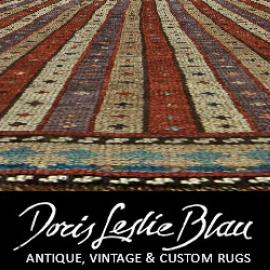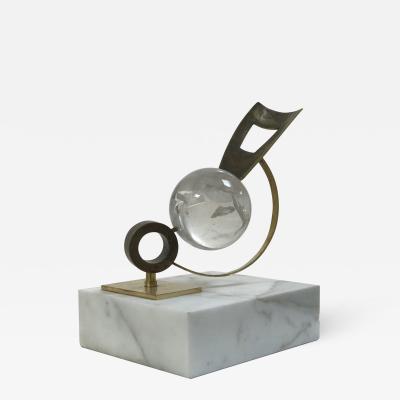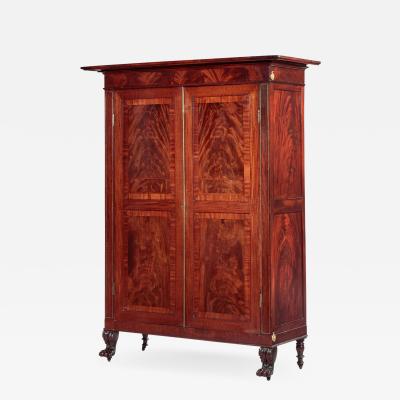Classical Revival
Classical Furniture Graces a Greek Revival Home
The adage, “it’s not just what you know, it’s who you know” applies to collecting as it does in life, according to the owners of an 1837 Beacon Hill row house in Boston, Massachusetts. This couple moved into the building in 1979 and began collecting seriously in the 1990s, relying on a combination of self-education and a network of fellow collectors, advisors, and dealers to help them amass a very fine collection of classical furniture from Boston, New York City, and Philadelphia, circa 1825–1840.
The couple “began tentatively,” says Carswell Rush Berlin, a New York City dealer specializing in American classical furniture, who has helped the husband and wife build their collection. “But they have become very enthusiastic collectors.” In addition to the splendid Greek Revival house and period furniture, Berlin notes that the couple “has one of the greatest collections of period lighting for a private home in the country, made additionally special by being original to the house.”
The gem of the collection is the Greek Revival row house itself, designed by Edward Shaw (1784–1859) for Adam Thaxter, Jr (1807–1862), a well-to-do merchant, his wife, Mary, and their family. The Thaxters joined other wealthy Bostonians flocking to the newly developed south side of Beacon Hill in the late 1790s and early 1800s. In The Book of Boston (1916) Robert Shackleton (1860–1923) described the houses these Boston Brahmins built: “They are generous, comfortable, well proportioned, dignified houses, with their soft-toned brick and their typical bowed fronts and their general air of spaciousness and geniality….”

- Many of the home’s lighting fixtures were most likely purchased by the original owners. This chandelier is from Thomas Messenger and Sons of London and Birmingham, England, circa 1830. As one of the largest makers of oil lamps in England at the time, the Messenger firm provided merchandise to retailers from Boston to New Orleans. The raised platform visible here was built to provide enough headroom to walk horses through a passageway below that ran from a preexisting stable on another property to the street. When the couple moved in, the stair railings were covered in a black paint (see opposite page), which the couple removed. The classical landscape painting is by Michel Felice Cornè (1752–1845). Cornè emigrated from Italy to America as a young man. Before moving to Boston in 1806, he helped establish the tradition of marine painting in the Salem area.
Federal, Victorian, and Greek Revival architecture can all be found in Beacon Hill, but the latter was in its ascendancy when the Thaxters built their house in 1837. Sparked by the discovery of Herculaneum and Pompeii in the second quarter of the eighteenth century, interest in all things classical swept across Europe, reaching America by the late 1700s. Often called “the first truly national style in the United States,” Greek Revival architecture can be found in all regions of the country.
By the time our collectors started looking in Beacon Hill, gentrification had not yet reached the neighborhood. “The houses needed a lot of work,” says the husband. While walking down the street with an architect friend after touring yet another house in which the once elegant, high-ceilinged rooms had been chopped up into small apartments, our couple came across the place they would soon call home. It was a fortuitous stroll. Approaching a brick row house, their friend told them the owner had just died and wondered aloud what would happen with the property. “We asked, ‘What’s it like inside?’,” recalls the husband. “He told us, ‘It’s just the way it was built.’”
That was enough information to encourage our couple to pursue the property. They eventually discovered that the Thaxters sold their home to Dr. Jacob Bigelow (1786–1879), Rumford Professor of Medicine at Harvard University and a leader in the garden cemetery movement in the United States. Thomas Bailey Aldrich (1836–1907), editor of the Atlantic Monthly from 1881 to 1890, was another illustrious owner. Our couple bought the house from the estate of Aldrich’s daughter-in-law, Eleanor née Little, sister to Bertram Little, who was the director of The Society for the Preservation of New England Antiquities (now Historic New England) for twenty-one years. “A lot of people thought we were crazy,” remembers the husband.
Though there was a lot of surface grime, and the plumbing and electrical systems needed work; the house was otherwise well preserved. The lighting was original but much of it was disfigured by the ugly pipes and wires of gasification and later, electrification. The couple didn’t realize the true worth of the fixtures until they invited Carswell Berlin to look at photographs of the pieces they had taken down and stored in the attic. The wife recalls, “He told us ‘These light fixtures would have been installed by the person who built your house.’ So needless to say back up they went.”
The house was sparsely furnished for years while the couple worked on restoring the building. The husband says, “We really loved the architecture of the house and that’s what we focused on for a really long time. Then we realized, ‘Gee, we need to sit down somewhere…we need to get some furniture.’ ”
They were unsure how to proceed until the wife’s sister made an observation. The wife recalls, “She said, ‘It’s a Greek Revival house. What you should have in here is furniture that people in the Greek Revival bought.’ And that was classical furniture.”
Classical furniture in the United States, says Carswell Berlin, “was a uniquely American interpretation of English and French furniture designs of the late eighteenth and early nineteenth century. It was made by designers and cabinetmakers, often of European origin and training, in Boston, New York, Philadelphia, and Baltimore, the principal high-style furniture making centers of the new American Republic between 1790 and 1840.” The late classical period encompasses Directoire, Restauration, and Empire styles, all of which take their names from periods in French political history.
Minds made up, our collectors began an ongoing process of learning, looking, listening and buying Classical furniture. They already had a relationship with Richard Nylander (Chief Curator) and other experts at the SPNEA/HNE to whom they had turned for advice on restoring the house. “We had a lot of help from them. It sharpened our senses about what was appropriate and what wasn’t in preserving an old house,” says the husband. Now they began to investigate period furniture, enrolling in classes, attending forums, networking, and reading everything they could find on the subject.
Through contacts at HNE, they met Stephen Harrison, curator of decorative art and technology at the Louisiana State Museum in New Orleans (now curator of decorative art and design at the Cleveland Museum of Art). Harrison became their eyes and ears in New Orleans, where Boston-made classical furniture was often to be found at auction. When pieces they’d purchased at a distance arrived on their doorstep, “It would be like Christmas…,” remembers the husband.
The couple formed friendships with other collectors they met at auctions and through organizations such as HNE and a collectors group associated with the Ellis Memorial Antiques Show held in Boston every Fall. Each new relationship brought more opportunities to learn. They also had help from dealers such as Berlin, Stuart Feld of Hirschl & Adler Galleries, and Diana Bittell. “They’ve helped us upgrade and find better examples,” says the husband.
The couple explains that the parameters of the collection are defined by the house so anything they purchase “has to be complementary.” Even though nineteenth-century affluent Bostonians preferred to patronize local cabinetmakers, they haven’t restricted their purchases to Boston-made furniture, “because that would rule out too many interesting things from New York, Philadelphia, even Europe.”
As they’ve learned more, the couple has begun replacing early purchases with pieces that can be attributed to a specific maker. A good example is a mahogany and bird’s-eye maple chest of drawers, circa 1815–1820, by Salem cabinetmaker William Hook (1777–1867). “We sold what was probably an American classical chest—it could have been British—and replaced it with what we think is a fine piece of Massachusetts furniture. We know where it was made, we know who made it, we know when it was made,” says the husband.
In recent years, they have expanded their collecting pursuits to include the work of period artists such as Augustin Edouart (1789–1861), Michele Felice Cornè (1752–1845), Jacob Petersen (1774–1855), Antoine Roux Sr. (1765-1835), Charles Woodbury (1864– 1940), John Smart (ca. 1740–1811), and Catherine Davis (ca. mid 1800s); a self-portrait by contemporary artist Julie Heffernan (b. 1956) has also become a part of the collection. Though they’ve made some good selections, the couple humbly admits to being novices in the fine art market. “Were just beginning, but it’s fun,” says the husband.
This couple’s willingness to investigate new fields of knowledge and to reach out to others for help is the secret to their success as collectors. The husband advises newcomers to “go find some experts…take the furniture courses…have patience and try to get in a network of people…” His wife adds, “Train your eye…. Go to forums and read…. It makes such a difference.”
This article was originally published in the Autumn/Winter 2007 issue of Antiques & Fine Art magazine, a digitized version of which is at afamag.com. AFA is affiliated with Incollect.com.






















































